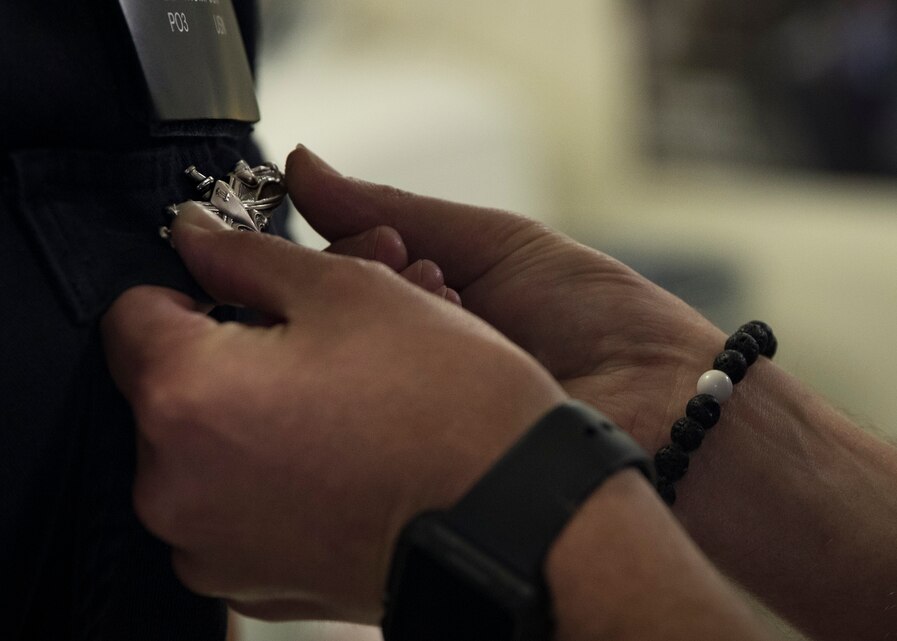
Every day, Marines and Sailors around the globe work alongside one another on ship and ashore. This relationship is one that has become even more critical as the Marine Corps continues to modernize its force for the future.
The Enlisted Surface Warfare Specialist pin is primarily offered to Sailors, but aboard amphibious assault ship USS America, the opportunity was recently offered to Marines as well. Five Marines with the 31st Marine Expeditionary Unit’s Combat Logistics Battalion 31 had the unique opportunity to integrate with the Navy by earning their ESWS pins while embarked aboard America, in recent months. This training, all done aboard ship while underway in the East and South China Seas, and Philippine Sea, was conducted before and after the 31st MEU’s participation in Exercise Cobra Gold 2020 in the Kingdom of Thailand.
ESWS qualification signifies that a Sailor or Marine has achieved a level of proficiency in surface ships and is competent with general knowledge in all the facets of the ship. According to Senior Chief Hospital Corpsman Michael Roby, a health service support senior enlisted leader with CLB-31, 31st MEU, ESWS training covers engineering plant capabilities, navigational equipment, deck equipment, air defense, interface and control links, information operations and combat systems and command, control, communications, computers and intelligence. This intense curriculum makes graduates significant contributors to the amphibious task force.
“Whenever you have the opportunity to cross-train and learn something different other than your specialty, it makes you a more well-rounded Marine and warfighter,” said Roby.
For Sgt. Elizabeth Kruggel, a landing support specialist with CLB-31, 31st MEU, and recent recipient of the ESWS pin, her inspiration for pursuing the pin came two years ago on her first deployment at sea aboard amphibious assault ship USS Wasp with the 31st MEU.
“I remember seeing all of the Navy personnel studying in the mess decks for their ESWS,” said Kruggel. “Since then I’ve always wanted the opportunity to pursue it.”
In order for the Marines to begin the course, they had to first pass a qualifying test and get approval from the ship’s command. Once meeting this requirement, the Marines took classes after work hours and conducted ten days of “walk-though” requirements to learn all the different functions of the ship. Next, they underwent a “murder board” with senior enlisted Sailors, and a final board with the ship’s command master chief, testing their knowledge on engineering plant capabilities, combat systems, and basic deck equipment.
“Marines cannot be passive passengers en route to the amphibious objective area. As long-range precision stand-off weapons improve and diffuse along the world’s littorals, Marines must contribute to the fight alongside our Navy shipmates from the moment we embark.” General David H. Berger, 38th Commandant of the Marine Corps
“For Sailors and Marines the training is important so that we learn every nook and cranny of the ship, and to further understand jobs and rates that are not your own to gain an appreciation for what each Sailor does,” said Kruggel.
For Kruggel, all of the training, especially the tours in the hot, dungeonous depths of the engineering section to understand the inner workings of the ship, gave her a newfound appreciation for the Sailors she serves alongside.
“Learning what they do on a day-to-day basis has changed my point of view of being a Marine on their ship. I have a greater appreciation for our Navy brothers and sisters,” Kruggel went on to say.
Although due to uniform regulations Marines cannot wear the ESWS pin, the training and the honor of earning the ESWS made the hard work worth it, according to Cpl. Conor Cromer, a landing support specialist with CLB-31, 31st MEU.
“I loved learning all about the Navy and USS America,” said Cromer. “It was not easy, and though we do not get to wear the pins, getting pinned has been one of my proudest moments on the America.”
For Marines, earning the ESWS pin is more than receiving an award for completing a course, it demonstrates and furthers the Naval integration that 38th Commandant of the Marine Corps, General David H. Berger has laid out in his most recent Commandant’s Planning Guidance.
“Marine Corps integration into the Fleet via composite warfare will be a prerequisite to the successful execution of amphibious operations,” Berger wrote. “Marines cannot be passive passengers en route to the amphibious objective area. As long-range precision stand-off weapons improve and diffuse along the world’s littorals, Marines must contribute to the fight alongside our Navy shipmates from the moment we embark.”
According to CLB-31 commanding officer Lt. Col. Christopher Johnson, training like ESWS is the tactical-level Naval integration that allows Marines and Sailors to operate from a common baseline when conducting amphibious operations, and makes the Marines of the 31st MEU active and lethal passengers, ready to enhance the ship’s capabilities the moment they embark.
“The future of the Marine Corps is clearly Naval Integration in order to enable Fleet maneuver,” said Johnson. “This training is an initiative we’ve undertaken with the support of the ship’s captains and their command master chiefs. Navy warfare qualifications are hard earned, and I am proud of all my Marines and Sailors who made the effort to earn their ESWS.”
America, flagship of the America Expeditionary Strike Group, 31st MEU team, is operating in the U.S. 7th Fleet area of operations to enhance interoperability with allies and partners and serve as a ready response force to defend peace and stability in the Indo-Pacific region.



